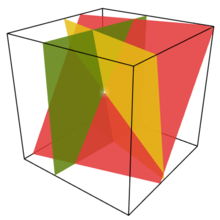Range of a Three Variable Fun-ction !!
 I
f
t
h
e
r
a
n
g
e
o
f
a
t
h
r
e
e
v
a
r
i
a
b
l
e
f
u
n
c
t
i
o
n
f
(
x
,
y
,
z
)
=
x
2
+
y
2
+
z
2
x
y
+
y
z
+
x
z
c
a
n
b
e
w
r
i
t
t
e
n
a
s
[
a
,
b
]
.
F
i
n
d
a
+
b
.
I
f
t
h
e
r
a
n
g
e
o
f
a
t
h
r
e
e
v
a
r
i
a
b
l
e
f
u
n
c
t
i
o
n
f
(
x
,
y
,
z
)
=
x
2
+
y
2
+
z
2
x
y
+
y
z
+
x
z
c
a
n
b
e
w
r
i
t
t
e
n
a
s
[
a
,
b
]
.
F
i
n
d
a
+
b
.
Note: ( a , b , c ) = ( 0 , 0 , 0 ) . The values could be negative.
The answer is 0.5.
This section requires Javascript.
You are seeing this because something didn't load right. We suggest you, (a) try
refreshing the page, (b) enabling javascript if it is disabled on your browser and,
finally, (c)
loading the
non-javascript version of this page
. We're sorry about the hassle.
4 solutions
Moderator note:
That's a really nice interpretation with the dot product, relating it to the cosine of the angle between these vectors.
W e k n o w t h a t : ( x + y + z ) 2 = ( x 2 + y 2 + z 2 + 2 x y + 2 y z + 2 x z ) ≥ 0 ⇒ x 2 + y 2 + z 2 x y + y z + x z ≥ − 2 1 . . . . . . . . . . . ( i ) N o w : x 2 + y 2 + z 2 − x y − y z − x z = 2 1 ( ( x − y ) 2 + ( y − z ) 2 + ( x − z ) 2 ) ≥ 0 ⇒ x 2 + y 2 + z 2 x y + y z + x z ≤ 1 . . . . . . . . . . . . . ( i i ) B y ( i ) a n d ( i i ) w e c a n s a y t h a t r a n g e o f f ( x , y , z ) i s [ 2 − 1 , 1 ] ∴ a + b = 0 . 5
SInce ( x + y + z ) 2 = ( x 2 + y 2 + z 2 ) + 2 ( x y + y z + z x ) , the given function is equal to f ( x , y , z ) = 2 1 ( x 2 + y + 2 + z 2 ( x + y + z ) 2 − 1 ) . Interpreting R 2 = x 2 + y 2 + z 2 as the square radius of a sphere centered at zero, and x + y + z as the dot product of a vector lying on that sphere with 1 , 1 , 1 .
Maximum value: Choose vector on the sphere parallel to 1 , 1 , 1 . The coordinates are x = y = z = ± 3 1 3 R and we find ∣ x + y + z ∣ = 3 R .
Minimum value: Choose vectors on the sphere perpendicular to 1 , 1 , 1 . There are infinitely many such vectors (lying on a ring). They satisfy ∣ x + y + z ∣ = 0 .
Substituting the minimum and maximum values of ∣ x + y + z ∣ into the equation, we find that f lies between 2 1 ( ( 3 ) 2 − 1 ) = 1 (max) and 2 1 ( 0 2 − 1 ) = − 2 1 (min).
Sorry but i think that this question is overrated. It should be of level 3
For the sake of variety, let me submit a geometrical solution; I like to see what I am doing.
Using the dot product, we can write f ( x , y , z ) = ∣ ∣ ( x , y , z ) ∣ ∣ 2 ( x , y , z ) ⋅ ( y , z , x ) = cos ( θ ) , where θ is the angle between the vectors ( x , y , z ) and ( y , z , x ) . Now ( y , z , x ) is obtained by rotating ( x , y , z ) through 2 π / 3 about the line spanned by ( 1 , 1 , 1 ) , a permutation of the axes. Thus 0 ≤ θ ≤ 2 π / 3 and [ a , b ] = [ cos ( 2 π / 3 ) , cos ( 0 ) ] = [ − 1 / 2 , 1 ] . Finally, a + b = 0 . 5 .